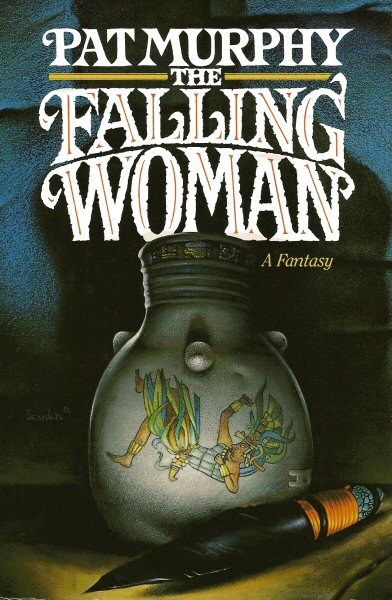Catch Me As I Fall
The Falling Woman
By Pat Murphy

14 Jun, 2019
1986’s The Falling Woman is a standalone Nebula-Award-winning fantasy by Pat Murphy.
Elizabeth Waters has escaped unwanted motherhood and a stultifying marriage at great cost to herself. Her reward: a career as a field archaeologist. Elizabeth is a valuable colleague at any dig because she seems to have a sixth sense for promising sites.
This is because she has a literal sixth sense. She sees the shades of the dead. The ghosts of the past guide her.
Elizabeth’s work at a dig at Dzibilchaltún (a Maya site in the Yucatan) is complicated when her estranged daughter Diane appears without warning. Diane’s father, Elizabeth’s ex, has died unexpectedly. Diane’s ill-fated love affair with an entirely unsuitable man has ended badly. What better time to go back to mom? It works. Parent and child bond again.
But this does not please one of the ghosts of Dzibilchaltún, Zuhuy-kak. Alive, she was a powerful priestess; dead, she’s a powerful and unhappy spirit.
Zuhuy-kak sacrificed her own child in hopes that this would protect her people from invading Toltecs. It did not. The Maya were crushed and their town occupied. The invaders in their turn sacrificed the priestess, throwing her into a cenote. Zuhuy-Kak survived the plunge. She was then revered as a messenger from the gods. Her message:
“Give yourselves up, my younger brothers, my older brothers. Submit to the unhappy destiny of the katun that is to come. You must leave the cities and scatter in the forests. You must cast down the monuments and raise no more. That is the word of the katun that is to come.”
People obeyed. Once bustling cities became ghost towns.
Many years later, Zuhuy-kak notices Elizabeth, another mother. She will help Elizabeth, and the dig, telling them where to dig, but there’s a cost. Elizabeth must also sacrifice her daughter.
~oOo~
It seems this is James Reads Books About The Ghosts of Women Tossed Down Wells Week.
Modern readers might be surprised to learn that Elizabeth had to give up her daughter to her ex as the price of divorce. When the divorce happened (twenty-five years before 1984, when the novel is set) no-fault divorce was not the American default1. I only mention this as the days of antiquated laws pertaining to marriage, divorce, and gender relations are so far in the past that modern readers might not grasp the context.
Other setting details: Elizabeth has taken the time to learn a modern Mayan language. This may not be the same language, or dialect, that Zuhuy-kak spoke, but it’s close enough that they can understand each other. Point to the author. She doesn’t assume that the Maya vanished a thousand years ago; she knows that there are millions of Maya living today. Sure, abandoned cities in the jungle, but that doesn’t mean that the descendants of the city-builders don’t exist.
As to the model of the Mayan past that the setting presupposes: I have the impression that it’s true to the state of the art as of 1984. I’m not sure how far the professional consensus has changed (not being up on Mayan archaeology).
I’m disposed to trust Murphy on the archaeology because she is so good at describing the realities of fieldwork: funding issues, injuries from falling rocks or collapsing trenches, rattlesnake bites, and dysentery epidemics sidelining the entire coffle of grad students.
She doesn’t cater to reader expectations (based on films like Raiders of the Lost Ark or The Mummy) involving Nazis, monsters, or sultry co-eds tempting male team leaders2.
Though there are the usual ghosts. It’s just that in this case, all the ghost can do is talk. Zuhuy-kak cannot blot out the sun or summon an army of the undead. Nonetheless, the novel effectively presents the ghost as a threat. Elizabeth is fragile; the ghost is persuasive. This is a subtle psychological thriller, written by an author at the top of her game.
The Falling Woman is available here (Amazon), here (Amazon.ca) and here (Chapters-Indigo).
1: The first state to allow no-fault divorce was California, in 1969. Other states followed suit.
You don’t want to know what it took to get divorced in Canada back in the early 20th century. (Well, if you do …)
2: Reality: predatory team leaders pressuring female grad students for sex. Archaeology is having its MeToo moment right now.
